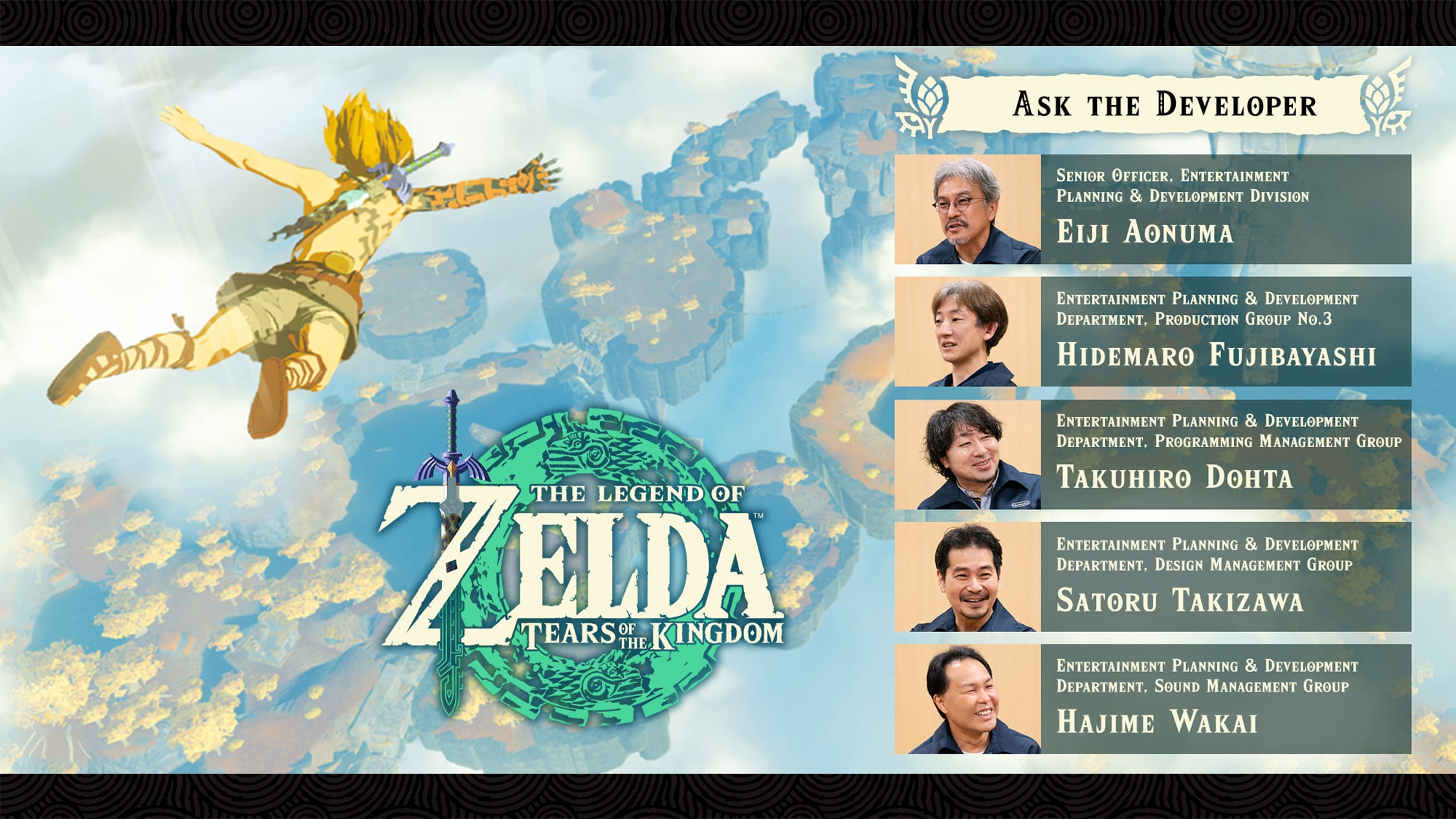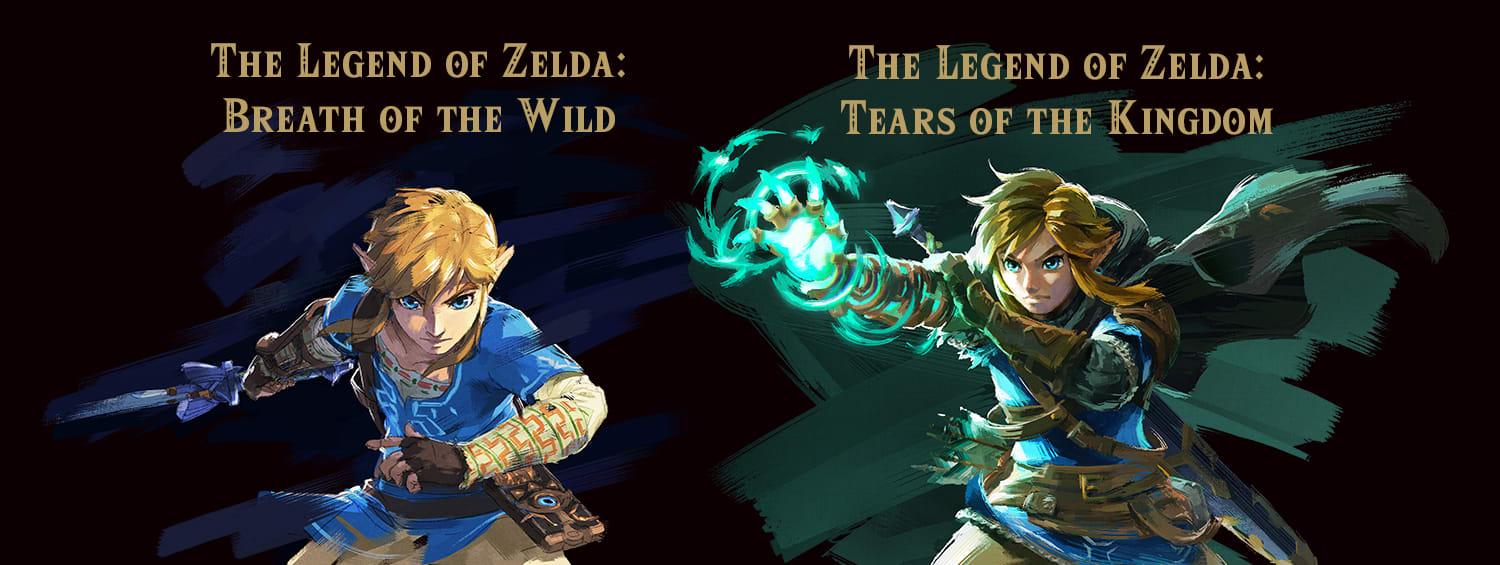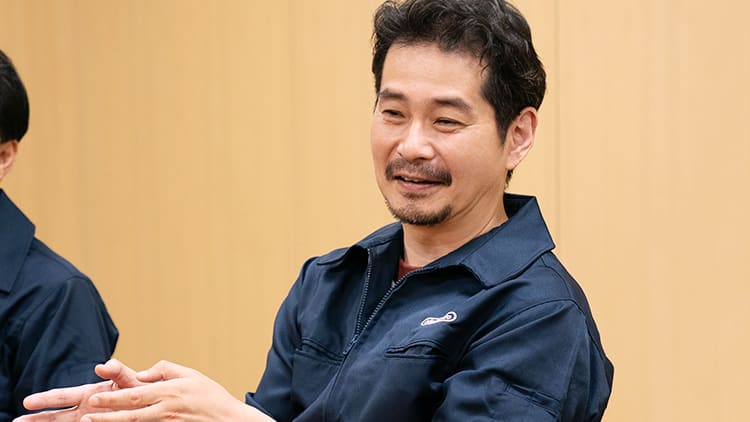
Ask the Developer Vol. 9, The Legend of Zelda: Tears of the Kingdom—Part 2
This article has been translated from the original Japanese content.
The images shown in this interview were created during development.
Check out the rest of the interview:
Part 2: Linking hands
Now let’s move on to the things that have changed from the previous game. Speaking of which, I immediately noticed that Link looks a little different in this title, doesn’t he?
Aonuma: Yes, his right arm. We wanted an iconic feature that would make it obvious at first glance that it's the Link from this game. Speaking of Link's arm, “hands” is a major theme in this title.

“Hands”? Can you elaborate on this?
Fujibayashi: Titles in the Legend of Zelda series intertwine all the elements of gameplay, mechanics, and story, and combine them all into a single game. For this title, we chose “hands” as the key theme to bring them all together. For example, abilities that Link uses to solve puzzles are all released from his hand and arm. We even included this symbolically in the game's mechanics, such as having scenes that use hands when opening special doors. This "hands" theme also crops up here and there as a key element as the story develops.
Dohta: The previous game was a relatively lonesome game, or rather an endurance game where you made full use of Link's body and strength alone to traverse the vast world. What's unique this time is joining hands and cooperating with various characters, and at times, creating items with Link's own hands and utilizing them as you progress.
Takizawa: We were intentional about making this “hands” theme show through in the visuals as well as in the story direction. If you watch the trailers that we've released so far, I think you may be able to get a sense of this atmosphere.
Wakai: We also expressed the “hands” theme by implementing handclaps and such in the game's music.
Aonuma: Well, simply put, "hands" expresses the idea of "connecting." This applies to the story too, which connects to Hyrule's past. It also talks about a major struggle called "The Imprisoning War," which until now was considered a myth even in Hyrule.
Fujibayashi: And the protagonist's name is "Link" after all.
Aonuma: Oh... I just got the connection... (Laughs)
Everyone: (Laughs)
Aonuma: It’s funny how these things work out, isn’t it? You don’t notice these things when you’re developing the game. But then after you’re done, you see that all sorts of things were actually connected. And you realize, “Oh, so that’s what we were doing...” you know?
So there are certain fundamental things that you wouldn't change because it's a sequel, and it becomes a matter of creating something new within those existing boundaries. It all sounds pretty challenging.
Aonuma: We set those boundaries ourselves, but new gameplay elements are born when we break through them. So we were "breaking boundaries."
Takizawa: “Breaking boundaries." That’s a good phrase!
Aonuma: Turns out that a lot of the boundaries were pretty durable. (Laughs)
Everyone: (Laughs)
Takizawa: On the other hand, the sound maintained just the right number of similarities with the previous title so that it feels like an adventure in the same world.
Wakai: Exactly. We intended to keep iconic sounds from the previous title, such as the sounds that play when you obtain an item or solve a puzzle.
Aonuma: Breaking boundaries doesn't mean you can just destroy whatever you like, though. Those boundaries give you the basis to feel safe about taking risks elsewhere.
No matter how everything else changes, when you hear those sounds, you'll think, "Oh, that's a Legend of Zelda game!" right?
Aonuma: That reminds me of how the word “déjà vu” cropped up many times during development. We were supposed to be making something different, but the various things we made gave off a similar impression to what we'd done previously. But as development went on, we'd look at the game as a whole and sometimes discover that those things suddenly took a different shape because of the new elements we'd added. Until then, we were anxiously trying to change things up, but at some point, we realized that some of them were already as they should be.
So there was one approach to make changes to remove that "déjà vu" feeling. And there was another to keep things the same because that's the way they should be. Was everyone on the development team on the same page from early on about those two approaches?
Fujibayashi: Not in the slightest. There were many instances, even later on in development, where we struggled to differentiate the two. It was a constant and difficult process where we and the development team continued to mull over and discuss until we all came to an agreement.
Takizawa: We often experienced strong déjà vu, particularly in the early stages, and we thought it was imperative to transform how the game felt as much as we could. We worked hard with that thought in mind, but once we got to a certain point in development, we were able to identify areas that would lose their appeal if we changed them.

Fujibayashi: We started to think positively by calling what we decided not to change "the Great Mundanity." (Laughs)
Takizawa: By the end, the definition of this “Great Mundanity” became clear, so even if a team member approached us about a déjà vu feeling, we felt more comfortable asking them to intentionally keep something unchanged.
I suppose it’s like when a sense of values that isn't shared by everybody eventually clicks into place through trial and error.
Aonuma: Video game development is always like that. When various pieces come together and things start clicking into place, there's a moment when "This is fine..." becomes "This is it!"
